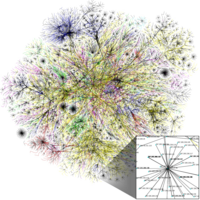
Photo from wikipedia
While the 5-th generation of communication networks (5G) is taking its first deployment steps, high doubts still concern the fulfilment of the stringent requirements of its slices. To meet these… Click to show full abstract
While the 5-th generation of communication networks (5G) is taking its first deployment steps, high doubts still concern the fulfilment of the stringent requirements of its slices. To meet these complex requirements, robust access networks should support the current 5G air interface. In this regard, space and air networks, namely satellites and unmanned aerial vehicles (UAVs) are expected to play a key role due to wide coverage and flexible deployment, respectively. Currently, the integration of these platforms in the terrestrial networks is weak though. Therefore, we suggest bridging this gap by designing a heterogeneous traffic offloading approach in the space-air-ground integrated network (SAGIN). Our innovative offloading approach covers the co-existing requirements of two heterogeneous slices of 5G by offloading smartly the traffic to the appropriate segment of SAGIN. Specifically, the ultra-reliable low-latency communications (URLLC) traffic is offloaded to the UAV link and to the terrestrial link to satisfy its stringent requirements in terms of latency. However, the enhanced mobile broadband (eMBB) traffic is offloaded to the UAV link, to the terrestrial link and to the satellite link because it is less sensitive to delay but needs high data rates. Our offloading approach boosts the network’s availability and reduces the latency experienced in SAGIN through an efficient resource allocation and an optimized design of the UAVs trajectory. Our findings highlight the key role that the concrete integration between SAGIN segments plays to achieve a better quality of service (QoS) for different slices with heterogeneous requirements.
Journal Title: IEEE Access
Year Published: 2021
Link to full text (if available)
Share on Social Media: Sign Up to like & get
recommendations!